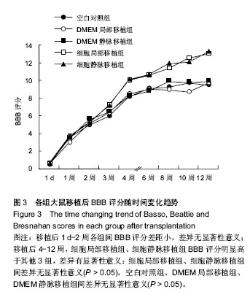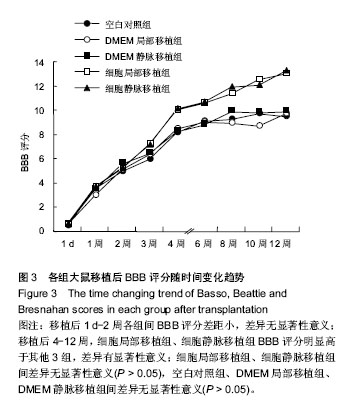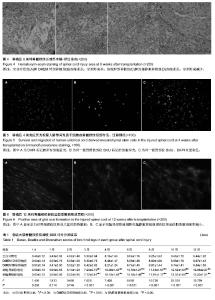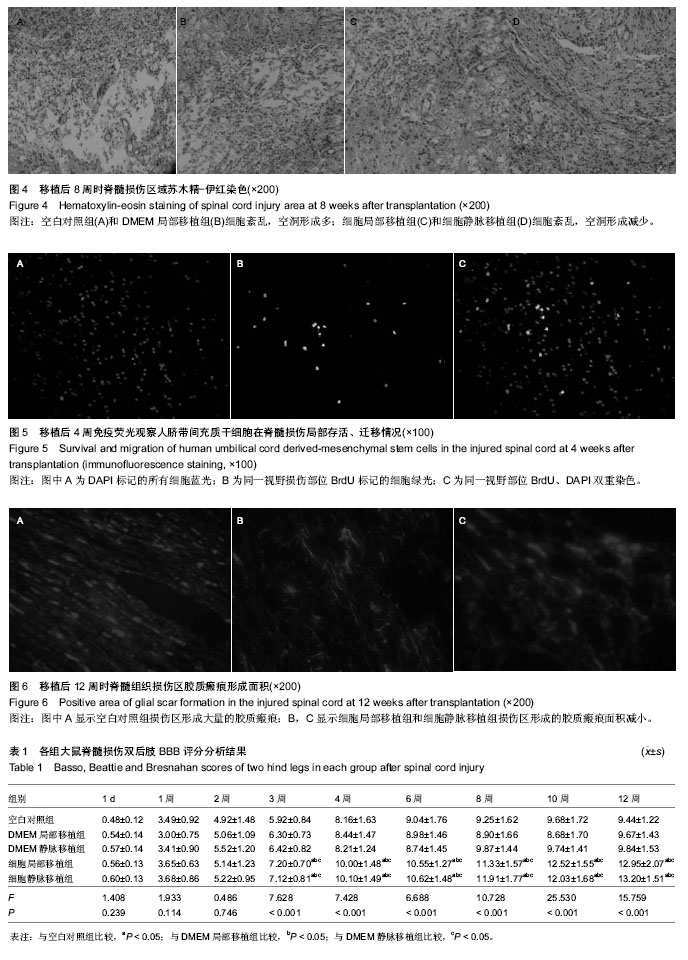Chinese Journal of Tissue Engineering Research ›› 2015, Vol. 19 ›› Issue (14): 2192-2198.doi: 10.3969/j.issn.2095-4344.2015.14.011
Previous Articles Next Articles
Transplantation of human umbilical cord derived-mesenchymal stem cells by different ways for the treatment of spinal cord injury
Liu Yu-liang1, Li Jun1, He Yu-qin1, 2, Zhuo Feng1, Wei Kai-bin1
- 1Taian City Central Hospital, Taian 271000, Shandong Province, China; 2Shanxian Hospital of Traditional Chinese Medicine, Heze 274300, Shandong Province, China
-
Revised:2015-03-03Online:2015-04-02Published:2015-04-02 -
About author:Liu Yu-liang, Master, Attending physician, Taian City Central Hospital, Taian 271000, Shandong Province, China -
Supported by:the Science and Technology Development Plan of Taian City, No. 20113076
CLC Number:
Cite this article
Liu Yu-liang, Li Jun, He Yu-qin, Zhuo Feng, Wei Kai-bin. Transplantation of human umbilical cord derived-mesenchymal stem cells by different ways for the treatment of spinal cord injury
share this article

2.1 人脐带间充质干细胞的培养和鉴定 倒置显微镜下观察组织块,于10 d左右见多数组织块周围长出大量新生细胞,形态多为长梭样、纺锤形,主要围绕组织块散在分布(图1),12-15 d时可见以组织块为中心周围细胞明显增多,细胞形态细瘦,类似成纤维样细胞,大体呈漩涡状或放射状分布。 传代培养后的细胞形态上大体一致,第5代时镜下可见大小均一,形态规则的成纤维样细胞(图2)。第3代细胞经过流式鉴定表明CD44、CD29、CD90、CD54阳性表达,而CD31、CD45、CD34、HLA-DR阴性表达,与其他研究结果相同[1-7]。 2.2 实验动物数量分析 实验过程中,空白对照组死亡0只,DMEM局部移植组死亡2只,DMEM静脉移植组死亡1只,细胞局部移植组死亡2只,细胞静脉移植组死亡1只,死亡后给予重新补充观察。 2.3 各组大鼠BBB评分 见表1,图3。术前所有大鼠双后肢肌力正常,即BBB评分均为21分,造模成功后均呈现双后肢全瘫,移植后第1天BBB评分为0分或1分,随后各组BBB评分呈现逐渐上升的趋势。移植后3周细胞局部移植组、细胞静脉移植组BBB评分分别为7.20±0.70,7.12± 0.81,明显高于空白对照组、DMEM局部移植组、DMEM静脉移植组,差异有显著性意义(P < 0.05),而细胞局部移植组、细胞静脉移植组间差异无显著性意义(P > 0.05),空白对照组、DMEM局部移植组、DMEM静脉移植组间差异无显著性意义(P > 0.05)。移植后1 d,1,2周各组之间比较差异无显著性意义(P > 0.05);移植后4,6,8,10,12周,细胞局部移植组、细胞静脉移植组与其他3组比较差异有显著性意义(P < 0.05),细胞局部移植组、细胞静脉移植组间差异无显著性意义(P > 0.05),空白对照组、DMEM局部移植组、DMEM静脉移植组间差异无显著性意义(P > 0.05)。 2.4 苏木精-伊红染色观察结果 第8周时苏木精-伊红染色可见空白对照组、DMEM局部移植组、DMEM静脉移植组损伤区域向内凹陷,损伤局部结构紊乱,瘢痕增生,局部形成空洞,细胞走行方向不一致。细胞静脉移植组和细胞局部移植组相近,两组形成的空洞及瘢痕较其他3组都相对减少(图4)。 2.5 免疫荧光染色和免疫组化染色结果 移植后4周时,细胞局部移植组和细胞静脉移植组在损伤局部可见BrdU阳性染色的人脐带间充质干细胞,未损伤的部位则未见到明显的阳性染色,阳性细胞数量自损伤部位向两端逐渐越少(图5)。移植后8周时人脐带间充质干细胞大部分集中在损伤的脊髓实质周围,12周时细胞局部移植组和细胞静脉移植组脊髓损伤局部仍然有BrdU阳性染色的人脐带间充质干细胞,但是局部存活的细胞数量比8周时有所减少。空白对照组、DMEM局部移植组和DMEM静脉移植组在8,12周都未见到任何阳性染色细胞。 细胞局部移植组和细胞静脉移植组标本在移植后第4周时可见空洞周围主要以纤维性星形胶质细胞为主,第8周时星形胶质细胞数量下降,第12周时脊髓损伤局部形成大量的胶质瘢痕,两组形成的胶质瘢痕面积较其他3组减少。细胞局部移植组、细胞静脉移植组无明显差异,空白对照组、DMEM局部移植组和DMEM静脉移植组之间无明显差异(图6)。"

| [1] Kita K, Gauglitz GG, Phan TT, et al. Isolation and characterization of mesenchymal stem cells from the sub-amniotic human umbilical cord lining membrane. Stem Cells Dev. 2010;19(4):491-502.
[2] Yoon JH, Roh EY, Shin S, et al. Introducing pulsed low-intensity ultrasound to culturing human umbilical cord-derived mesenchymal stem cells. Biotechnol Lett. 2009;31(3):329-335.
[3] Kadivar M, Khatami S, Mortazavi Y, et al. In vitro cardiomyogenic potential of human umbilical vein-derived mesenchymal stem cells. Biochem Biophys Res Commun. 2006;340(2):639-647.
[4] La Rocca G, Anzalone R, Corrao S, et al. Isolation and characterization of Oct-4+/HLA-G+ mesenchymal stem cells from human umbilical cord matrix: differentiation potential and detection of new markers. Histochem Cell Biol. 2009;131(2): 267-282.
[5] Chambers I, Colby D, Robertson M, et al. Functional expression cloning of Nanog, a pluripotency sustaining factor in embryonic stem cells. Cell. 2003;113(5):643-655.
[6] Ding DC, Shyu WC, Lin SZ, et al. Human umbilical cord mesenchymal stem cells support nontumorigenic expansion of human embryonic stem cells. Cell Transplant. 2012;21(7): 1515-1527.
[7] Jo CH, Kim OS, Park EY, et al. Fetal mesenchymal stem cells derived from human umbilical cord sustain primitive characteristics during extensive expansion. Cell Tissue Res. 2008;334(3):423-433.
[8] Kaptanoglu E, Tuncel M, Palaoglu S, et al. Comparison of the effects of melatonin and methylprednisolone in experimental spinal cord injury. J Neurosurg. 2000;93(1 Suppl):77-84.
[9] Muñoz-Elías G, Woodbury D, Black IB. Marrow stromal cells, mitosis, and neuronal differentiation: stem cell and precursor functions. Stem Cells. 2003;21(4):437-448.
[10] 冯善伟,姚晓黎,李中,等. Brdu体外标记大鼠骨髓间充质干细胞的研究[J]. 第一军医大学学报, 2005, 25(2):184-186.
[11] Anzalone R, Lo Iacono M, Corrao S, et al. New emerging potentials for human Wharton's jelly mesenchymal stem cells: immunological features and hepatocyte-like differentiative capacity. Stem Cells Dev. 2010;19(4):423-438.
[12] 孙丽,于丽,张华芳,等.人脐带间充质干细胞的分离培养及生物学特性[J]. 解剖科学进展,2011,17(2): 131-134.
[13] Huang P, Lin LM, Wu XY, et al. Differentiation of human umbilical cord Wharton's jelly-derived mesenchymal stem cells into germ-like cells in vitro. J Cell Biochem. 2010;109(4): 747-754.
[14] Anzalone R, Lo Iacono M, Loria T, et al. Wharton's jelly mesenchymal stem cells as candidates for beta cells regeneration: extending the differentiative and immunomodulatory benefits of adult mesenchymal stem cells for the treatment of type 1 diabetes. Stem Cell Rev. 2011;7(2): 342-363.
[15] Weiss ML, Medicetty S, Bledsoe AR, et al. Human umbilical cord matrix stem cells: preliminary characterization and effect of transplantation in a rodent model of Parkinson's disease. Stem Cells. 2006;24(3):781-792.
[16] Ding DC, Shyu WC, Chiang MF, et al. Enhancement of neuroplasticity through upregulation of beta1-integrin in human umbilical cord-derived stromal cell implanted stroke model. Neurobiol Dis. 2007;27(3):339-353.
[17] Yang CC, Shih YH, Ko MH, et al. Transplantation of human umbilical mesenchymal stem cells from Wharton's jelly after complete transection of the rat spinal cord. PLoS One. 2008;3(10):e3336.
[18] Li Z,Qin HJ,Feng ZS,et al.Human umbilical cord mesenchymal stem cell-loaded amniotic membrane for the repair of radial nerve injury.Neural Regen Res. 2013;8 (36): 3441-3448.
[19] 朱玉海,冯世庆,王雪.大鼠脐带华通胶来源MSCS修复脊髓损伤的实验研究[J].中国修复重建外科杂志, 2009, 23(12): 1491-1496.
[20] Chen H,Zhang Y,Yang ZJ,et al.Human umbilical cord Wharton’s jelly-derived oligodendrocyte precursor-like cells for axon and myelin sheath regeneration.Neural Regen Res. 2013;8 (10): 890-899.
[21] 冯大雄,钟德君,阳运康,等.静脉移植骨髓间充质干细胞对大鼠脊髓损伤后轴突再生的作用[J].中国脊柱脊髓杂志,2006,16(12): 937-941.
[22] Maikos JT, Shreiber DI. Immediate damage to the blood-spinal cord barrier due to mechanical trauma. J Neurotrauma. 2007;24(3):492-507.
[23] Vaquero J, Zurita M, Oya S, et al. Cell therapy using bone marrow stromal cells in chronic paraplegic rats: systemic or local administration. Neurosci Lett. 2006;398(1-2):129-134.
[24] Kuan WL, Barker RA. New therapeutic approaches to Parkinson's disease including neural transplants. Neurorehabil Neural Repair. 2005;19(3):155-181.
[25] Lu P, Jones LL, Snyder EY, et al. Neural stem cells constitutively secrete neurotrophic factors and promote extensive host axonal growth after spinal cord injury. Exp Neurol. 2003;181(2):115-129.
[26] Hofstetter CP, Schwarz EJ, Hess D, et al. Marrow stromal cells form guiding strands in the injured spinal cord and promote recovery. Proc Natl Acad Sci U S A. 2002;99(4): 2199-2204.
[27] Kang SK, Jun ES, Bae YC, et al. Interactions between human adipose stromal cells and mouse neural stem cells in vitro. Brain Res Dev Brain Res. 2003;145(1):141-149.
[28] Gerdoni E, Gallo B, Casazza S, et al. Mesenchymal stem cells effectively modulate pathogenic immune response in experimental autoimmune encephalomyelitis. Ann Neurol. 2007;61(3):219-227.
[29] Galli D, Gobbi G, Carrubbi C, et al. The role of PKCε-dependent signaling for cardiac differentiation. Histochem Cell Biol. 2013;139(1):35-46.
[30] Ruan ZB, Zhu L, Yin YG, et al. The mechanism underlying the differentiation of human umbilical cord-derived mesenchymal stem cells into myocardial cells induced by 5-azacytidine. Indian J Med Sci. 2010;64(9):402-407. |
| [1] | Yu Yu-qin, Hu Nian-chun, Duan Ji-an, Li Da-peng, Liu Chang. Neuroprotective effects of sufentanil preconditioning on spinal cord injury in mouse models [J]. Chinese Journal of Tissue Engineering Research, 2016, 20(40): 5966-5972. |
| [2] | Fan Xu-hui, Yang Bo, Hu Xiang, Guan Fang-xia. Reactive hyperplasia of glial cells induced by spinal cord injury in a rat model [J]. Chinese Journal of Tissue Engineering Research, 2016, 20(40): 6001-6006. |
| [3] | Jing Cai-xia, Liu Chang-kui, Tan Xin-ying, Luo Jin-chao, Hu Min. Bone mesenchymal stem cells with allogeneic bone to repair canine mandibular defects: detection of osteogenic ability [J]. Chinese Journal of Tissue Engineering Research, 2015, 19(14): 2138-2143. |
| [4] | Lv Pin-lei, Su Yue-han, Cao Yun, Wang Zheng. Treatment of osteoarthritis using colony-forming cells in stromal vascular fraction of adipose tissue [J]. Chinese Journal of Tissue Engineering Research, 2015, 19(14): 2149-2154. |
| [5] | Ruan Guang-ping, Yao Xiang, Liu Ju-fen, Wang Jin-xiang, Hu Yuan-yuan, Li Zi-an, Yang Jian-yong, Pang Rong-qing, Pan Xing-hua. Transplantation of human umbilical cord mesenchymal stem cells in the treatment of systemic lupus erythematosus [J]. Chinese Journal of Tissue Engineering Research, 2015, 19(14): 2172-2178. |
| [6] | Jiang Yan-jie, Mao Cheng-gang, Ning Xian-feng, Li Rong, Li Zi-pu. Human umbilical cord mesenchymal stem cells via intramuscular injection influence the expression of cytokines related to dilated cardiomyopathy in rats [J]. Chinese Journal of Tissue Engineering Research, 2015, 19(14): 2179-2185. |
| [7] | Wang Guo-xi, Wang Guo-qian, Zhang Shu-quan. Hyperbaric oxygen combined with Schwann cells transplantation for spinal cord injury in rats: electrophysiological and functional changes of the hind limbs [J]. Chinese Journal of Tissue Engineering Research, 2015, 19(14): 2205-2210. |
| [8] | Zhao Xiao-jian, Lu Cai-ping, Chu Wei-wei, Zhang Ya-xiao, Zhang Bing, Zhen Qiang, Tan Guo-liang, Wang Ren-feng, Liu Jia-bao, Wu Lin. Bone marrow mesenchymal stem cell transplantation for treatment of emphysema: intravenous versus intratracheal approach [J]. Chinese Journal of Tissue Engineering Research, 2015, 19(14): 2211-2215. |
| [9] | Liang Jian-ji, He Zhi-yong, Liu Kang, Li Xiao-ling, Cheng Wei-min, Yu Xin-ping, Chen Er-dong. Intraarticular injection of autologous bone marrow mesenchymal stem cells for mild-to-moderate osteoarthritis [J]. Chinese Journal of Tissue Engineering Research, 2015, 19(14): 2216-2223. |
| [10] | Wang Yong, Zhao Wei, Feng Jian-zhou, Chen Xiao-chun. Nerve growth factor-modified adipose derived stem cells for repair of spinal cord injury [J]. Chinese Journal of Tissue Engineering Research, 2015, 19(14): 2224-2229. |
| [11] | Liang Liang, Xu Tao, Song Yang, Sheng Wei-bin. siRNA lentiviral vectors carrying telomerase reverse transcriptase gene hasten astrocytes apoptosis [J]. Chinese Journal of Tissue Engineering Research, 2015, 19(11): 1707-1711. |
| [12] | Huang Jian-feng, Huang Ji-feng, Zhang Wei-cai. Bone marrow mesenchymal stem cells differentiate into neuron-like cells induced by combination of two cytokines [J]. Chinese Journal of Tissue Engineering Research, 2014, 18(6): 829-834. |
| [13] | Qu Xin, Wang Xin-chao, Han Lu, Zhang Hai-chao. Different sources of mesenchymal stem cells in the treatment of liver fibrosis in rats [J]. Chinese Journal of Tissue Engineering Research, 2014, 18(6): 926-931. |
| [14] | Li Hui-zhen, Li Meng, Li Rui-yu, Wu Li-ping. Effects of epimedium on osteogenic differentiation of bone marrow mesenchymal stem cells [J]. Chinese Journal of Tissue Engineering Research, 2014, 18(6): 979-984. |
| [15] | Yan Hao-ran, Cai Jun-feng, Shen Bin, Wen Jun-xiang, Tan Jun. Sodium hyaluronate for treatment of chondromalacia patella syndrome [J]. Chinese Journal of Tissue Engineering Research, 2014, 18(52): 8525-8528. |
| Viewed | ||||||
|
Full text |
|
|||||
|
Abstract |
|
|||||



